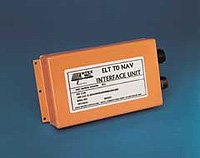Part #: 453-6500
NSN: |
5821-01-561-2912 |
OEM: |
ACR/Artex |
Desc: |
ELT to Nav Interface |
 Select part number above to view pricing and availability.
Select part number above to view pricing and availability.
| Price | Condition | Status | More Info | |
|---|---|---|---|---|
| REQUEST | NEW OUTRIGHT | REQUEST LEAD TIME |
|
|
| $3,280.00 | NEW OUTRIGHT | REQUEST LEAD TIME |
|

ELT To Nav Interface
- Designed to be connected between the aircraft's Flight Management Computer (FMC) or GPS receiver and the Artex 406 MHz series ELTs
- Receives continuous position updates from the aircraft's navigation system and translate it to the proper format for use by the ELT
- Upon activation the ELT transmits digitally the Latitude and Longitude of the aircraft to the COSPAS/SARSAT satellite system
- Knowledge of the position information allows SAR forces to launch an immediate mission to the last known position of the aircraft
- Use of this technology provides the following information the Search and Rescue teams: Type of Aircraft, Owner(s), Emergency Contact(s), Country Code, Serial Number of ELT, ELT Manufacturer, Latitude/Longitude position
- The interface unit will automatically reprogram an ELT (if programmed for long message 24 bit protocol), overwriting previously stored data, every time the interface unit determines that a new ELT with a different 24 bit aircraft address has been placed in the aircraft
| Part Number | Interface Description: |
|---|---|
| 455-6500 | see details above |
NSN: 5821-01-561-2912
| Price | Condition | Status |
|---|---|---|
| REQUEST | NEW OUTRIGHT | REQUEST LEAD TIME |
| $3,280.00 | NEW OUTRIGHT | REQUEST LEAD TIME |
Click on a question below to see the answer. If you have a question about this model that is not answered below, please contact questions@seaerospace.com
Why do some parts indicate "REQUEST" or “RFQ” on the Southeast Aerospace website?
In relation to NE (New) parts, many OEMs change their prices and availability without any notice to dealers or the industry. Therefore, through the REQUEST or RFQ indication, we ask that customers contact us for the most accurate price and availability.
In relation to SV & OH parts, the used parts aftermarket in the aviation industry is not an infinite supply. It is a dynamic, constantly changing market that is significantly affected by and susceptible to highs and lows in supply and demand. Therefore, although we attempt to, at times, we are unable to predict the exact moment when an item may be available. Once again, through the REQUEST or RFQ indication on our website, we ask that customers contact us for the most current and accurate price and availability.
What are the requirements for ELT installations?
Starting January 1, 2004 an approved ELT must be installed. An ELT meeting TSO-C91 installed prior to June 21, 1995 is acceptable. An ELT installed after June 21, 1995 must meet TSO-C91a or TSO-C126.
No person may take off an airplane for flight over water more than 30 minutes flying time or 100 nautical miles from the nearest shore, whichever is less, unless it has on board the following survival equipment:
- A life preserver, equipped with an approved survivor locator light, for each occupant of the airplane.
- Enough liferafts (each equipped with an approved survival locator light) of a rated capacity and buoyancy to accommodate the occupants of the airplane.
- At least one pyrotechnic signaling device for each liferaft.
- One self-buoyant, water-resistant, portable emergency radio signaling device that is capable of transmission on the appropriate emergency frequency or frequencies and not dependent upon the airplane power supply (FAR Part 91.509 [b]).
- A lifeline stored in accordance with Sec. 25.1411(g) of this chapter.
What is the meaning and purpose of the Artex ELT ending in part number -999?
Most Artex ELT systems are received by distributors programmed with the ELT serial number for use in the USA. Thus the P/N ends in -366. If the ELT is programmed for another country, then the appropriate labels are placed on the ELT. However, the original dataplate part number remains the same. Dealer/distributors who are authorized to program Artex ELTs are not permitted to change the part number of the ELT.
Therefore, if someone requires an Artex ELT to actually have the -999 part number then this must be requested before the distributor places the order with the factory. Otherwise, programmed ELTs can be programmed with a default hex address and ID to be equivalent to the -999 status. When this is done by an authorized programming facility, the dataplate remains the same but the separate label with country and three digit code becomes blank and the hex ID label indicates the default hex ID.
What is the service life for most ELT 406 MHz?
What does COSPAS mean?
 . These Russian words translate to "Space System for the Search of Vessels in Distress".
. These Russian words translate to "Space System for the Search of Vessels in Distress".

